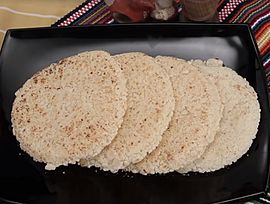Mbeju facts for kids
 |
|
| Type | Bread |
|---|---|
| Course | Breakfast or snack |
| Place of origin | Paraguay |
| Main ingredients | Cassava starch, fat, milk, egg, Paraguay cheese |
Mbeju is a special kind of flat, round cake. It is made from starch, often from the cassava plant. This tasty dish is very popular in Paraguay.
People have been making mbeju since the 1700s. Its story began with the Cario-Guarani people. They were an native group living near Asunción, the capital city of Paraguay.
The word "mbeju" means "cake" in the Guarani language. Guarani is one of the two official languages in Paraguay. Mbeju is an old recipe, important in Guarani mythology. There used to be many ways to make it, but today about 11 types are known. Mbeju is often eaten with drinks like "mate cocido", milk, or coffee. It can also be a side dish with other meals.
Contents
The History of Mbeju
Some historians believe that mbeju has a long history. A German traveler named Ulrich Schmidl wrote about it in the 1500s. He saw the Cario-Guarani people making a starchy bread. This was even before the Spanish arrived in Asunción.
The Cario-Guarani people called their bread "mbujapé." This word also means "bread" in Guarani. To make mbujapé, they mixed corn flour or cassava starch with animal fat. Then, they wrapped it in a banana leaf. They cooked it in hot ashes.
Paraguayan food is a mix of different cultures. It combines traditional Spanish cooking with Cario-Guarani recipes. This mix happened in Asunción and nearby towns. Franciscan priests, Spanish explorers, and local people helped create this unique food style. Towns like Tobatí and Areguá still show this cultural blend today.
When the Spanish arrived, they brought new foods. In 1556, they brought cattle to Asunción. This meant new ingredients like beef, milk, eggs, and cheese became available. The native foods like cassava and corn mixed with these new ingredients. This blend created many of the dishes eaten in Paraguay today. Mbeju is one of these dishes. It uses cassava, corn, Paraguay cheese, milk, and sometimes beef.
What You Need for Mbeju
Traditional mbeju uses a few simple ingredients. These include cassava starch, corn flour, and pork fat. You also need a little salt, fresh cheese, and milk.
There is a type called "mbeju avevo." This means "inflated cake." It uses more pork fat, eggs, and cheese. Another kind is "mbeju de fariña." This one uses manioc flour instead of cassava starch.
You can also find other mbeju recipes. For example, "mbeju cuatro quesos" means "mbeju with four cheeses." This recipe needs cassava starch, butter, and fresh cheese. It also uses milk and salt. For the extra cheese, it adds tomatoes, cuartirolo cheese, and catupyry cheese. Herbs like oregano and basil, plus black pepper, are also used.
How to Make Mbeju
First, you need to sift the cassava starch. This makes it light and fluffy.
Next, add the fat and crumbled cheese to the starch. Mix them together until they become creamy.
Then, add eggs, salt, and milk. Keep mixing everything well. Finally, add the rest of the starch and corn flour. Use your hands to mix it all. You want it to become a thick, crumbly mixture, like a coarse powder.
Now, get a frying pan and grease it. Heat the pan until it is very hot.
Put a layer of the mbeju mixture into the hot pan. Make it about 1½ centimeters thick. Gently press the edges with the back of a spoon.
Cook the mbeju for a few minutes. Move the pan around so it cooks evenly. This stops the center from burning.
To flip the mbeju, use the lid of the pan. Place the lid over the pan, then carefully flip the pan over. The mbeju will land on the lid. Then, slide it back into the pan to cook the other side. Cook it the same way until it's done.
Making Mbeju with Extra Cheese
For the extra cheese mbeju, start by putting Paraguayan cheese and butter in a bowl. Whisk them with a spoon until they are creamy.
Add the starch and a little salt. If the mixture gets too hard, add some milk. Whisk again until it is creamy.
For the filling, cut the tomatoes and the extra cheese into pieces.
In a hot pan, spread a layer of the mbeju dough. Cover the whole bottom of the pan. On top of this dough, add the cut tomatoes and cheese. Sprinkle with oregano, basil, and a little pepper.
Cover the filling with another layer of mbeju dough. Cook for about 3 minutes on each side.
See also
 In Spanish: Mbeyú para niños
In Spanish: Mbeyú para niños

